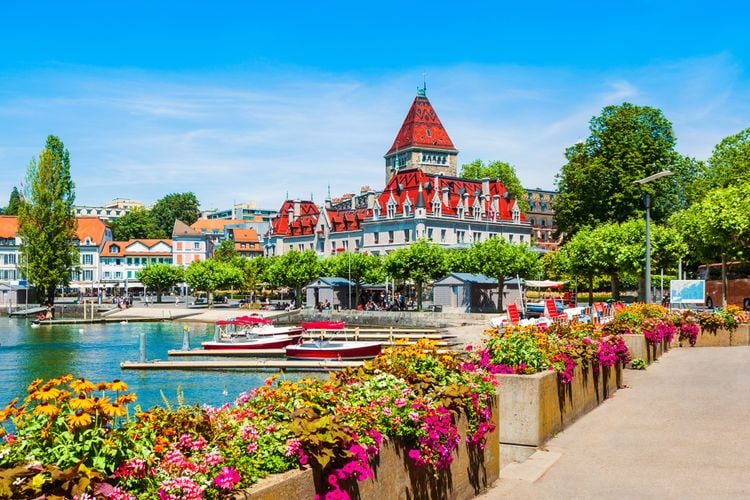Europe's largest lake crosses two countries: France and Switzerland. Its dual nationality gives it an attractive mix of landscapes and heritage, as well as tourist attractions.
The largest lake in Europe, Lake Geneva is geographically anchored between France and Switzerland. This long, blue, misshapen banana is divided almost equally between the two countries. For Switzerland, the northern shore and the two extremities, and for France, the southern shore. The border runs through the middle. The pride of the French, but also of the Vaudois, the lake can be explored from the air, on land or in the water. At the centre of the attractions, the lake offers breathtaking views of the Alps, coastal towns, monuments and vineyards.
The Vaud Riviera is one of these attractions, with its romantic setting largely due to the Château de Chillon, the setting for Rousseau's epistolary novel "La Nouvelle Héloïse". The fortified village of Yvoire, in Haute-Savoie, or the vineyards of Lavaux between Vevey and Lutry are other places to visit. A brief tour of Switzerland and France.
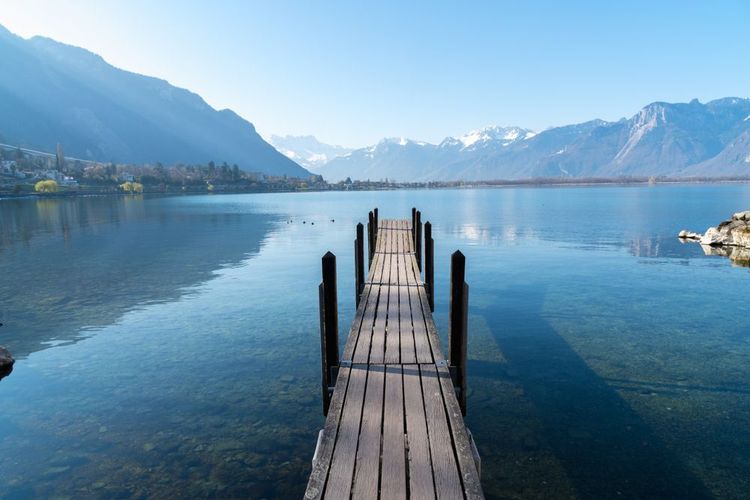
Lake Geneva, Europe's largest lake.
- © 2p2play / Shutterstock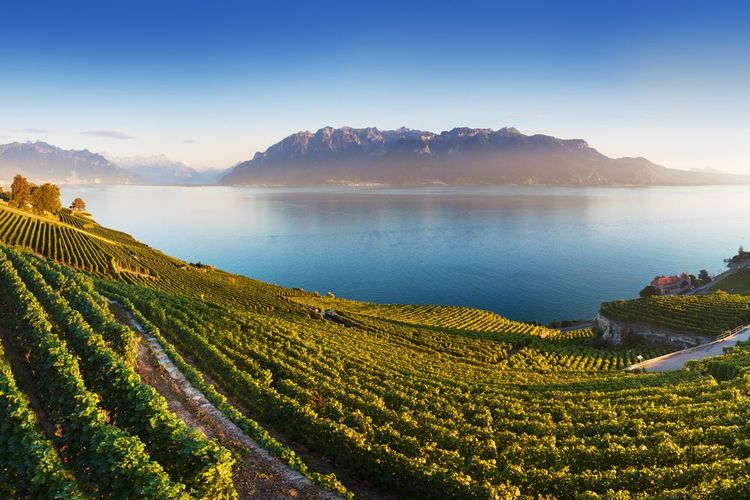
Panoramic view of the town of Vevey overlooking Lake Geneva and the vineyards of the famous Lavaux wine region.
- © Michal Balada / ShutterstockHistorically, it is still very difficult to determine its origin and formation. In fact, there are two schools of thought on the subject: on the one hand, the proponents of a tectonic origin, and on the other, the defenders of an erosive origin. The fact is that, whatever the origin of its formation, Lake Geneva, at 581.3 km², is the largest alpine and sub-alpine lake in Central Europe.
 Lausanne
Lausanne
Floatinn Boat-BnB
Located in a harbour facing Geneva's famous Jet d'Eau.The main attractions around the lake
The vineyards
Listed as a UNESCO World Heritage Site since 2007, the Lavaux vineyards lie between Vevey and Lutry and make for a lovely walk, as does the Ile de la Harpe, just a hundred metres away, which can be reached by swimming in summer.

Aerial view of the lake and its giant water jet
- © Samuel Borges Photography / ShutterstockThe giant water jet
Far from being the leaning tower of Pisa, Geneva's Jet d'eau is just as impressive. Visible when you fly into Geneva airport, this enormous fountain has taken up residence in Lake Geneva and rises to a height of over 140 metres. The best places to get a shot of the jet are from the Mont Blanc bridge and the lake promenade along the left bank or by taking a ferry.
Sport on the lake
Enjoy slow travel on Lake Geneva by taking up paddleboarding. The idea of standing on a long surfboard and using a paddle to move forward is a fun way to travel and explore the area. As well as paddleboarding, you can also enjoy other water sports such as windsurfing and wakeboarding.
A secret beach
Here's an address known to the locals, still protected from mass tourism: the small beach near the port of Le Perle du Lac. But to get there, you have to earn your way and do a few acrobatic moves past the steep gateway to the Perle du lac harbour.

Freddie Mercury shines in Montreux near Lake Geneva
- © saiko3p / ShutterstockQueen on Lake Geneva
Did you know? The British rock band Queen recorded in a studio in Montreux, near Lake Geneva. Today, this sanctuary is open to the public free of charge. Mountain Studios welcomed the band in 1978 to record their seventh album. In the 90s, the four virtuosos bought the walls of this studio. It was here that the band recorded songs for The Miracle, Hot Space and A Kind of Magic. The magnificent I Want it All still resonates today. This cult venue houses a museum (with objects, posters, handwritten lyrics and all the recording equipment) and not far from there stands the statue of Freddie Mercury, unveiled in 1996.
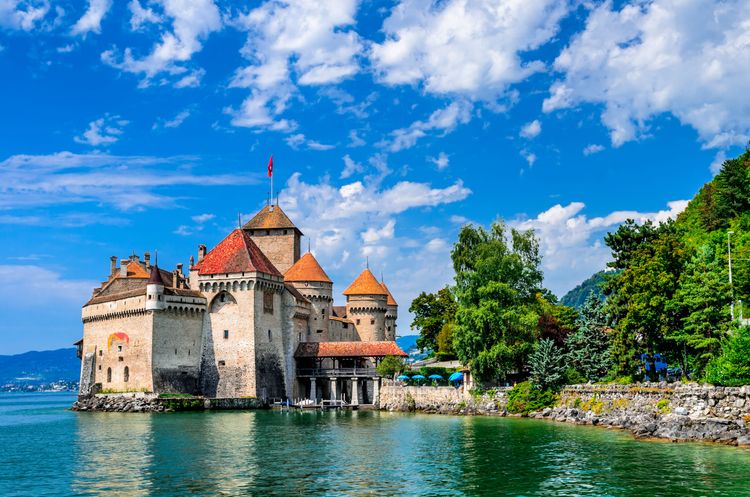
The majestic Chillon castle by the lake
- © ecstk22 / ShutterstockChillon Castle
A radiant beauty on the shores of Lake Geneva, Chillon Castle has existed since the Bronze Age and echoes the stories of counts and dukes, from the great feasts of old to the cells and darker tales. The castle impresses with its moat, double ramparts, turrets and towers... not forgetting its breathtaking views of the lake and the Alps. Located near Montreux, the building has inspired many artists and also boasts its own wine (Clos de Chillon). Its vineyards stretch across the slopes near the castle and are part of the Lavaux region.
Alimentarium
This museum devoted to nutrition is just a stone's throw from Nestlé and offers exhibitions designed to inform and entertain. You won't want to miss the huge fork sticking out of the water. It's the perfect place to relax and enjoy a picnic by the lake.
The village of Yvoire
In another setting, the fortified village of Yvoire, in Haute-Savoie, in the canton of Sciez, is one of the highlights of the lakeshore. Listed as one of the "Most Beautiful Villages in France", it has also won awards in the "Towns and Villages in Bloom" competition every year since 1959.

A train ride near the lake
- © CHEN MIN CHUN / ShutterstockThe lake by train
Trains are one of the most popular forms of transport in Switzerland and around Lake Geneva. Tourist and utility railways offer splendid panoramas, such as the Blonay-Chamby railway-museum. Hop aboard its steam train for a tour of the Riviera during the Belle Epoque. Admire the panoramic views of the Alps and the lake.
Train enthusiasts can also take the Lavaux Express through the terraced vineyards, lake and mountains.
The Golden Pass offers a panoramic journey from the Lucerne region via Interlaken to Montreux.
 Lausanne
Lausanne
Royal Hotel
Hotel overlooking Lake GenevaA boat trip
A boat trip on the lake is a must. There is a plethora of choice when it comes to finding a cruise, pedalo or luxury yacht. Throughout the year, yachts cross the lake, and some even offer a meal on board (a traditional fondue!).
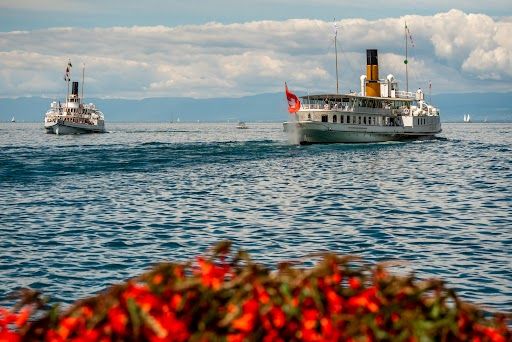
A cruise on the lake is a must!
- © HUA Heying / 123RF👉 Practical information
A few tips for driving between France and Switzerland:
If you're driving from France to Switzerland, you'll need to drive in daylight with your lights on - this rule has been in force in this territory since 1 January 2014. In most cases, parking in Switzerland is chargeable in town. Remember to have some change (Swiss francs) to pay the parking meter. On the road, motorway signs (limited to 120 km/h) are in green and road signs in blue. To access the motorways and expressways, you will need a Swiss vignette. If you don't have one, you can be fined 200 Swiss francs. You can buy this sticker near the border, in post offices, garages or petrol stations.
As you cross the border, you will encounter Swiss customs who will remind you to turn on your dipped headlights. There are no special formalities and crossing the border is relatively free. Remember to have your passport or identity card with you.
